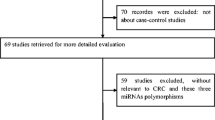Abstract
MicroRNAs (miRNAs) are small non-coding RNA molecules that function as negative regulators of gene expression. Common genetic variants (single nucleotide polymorphisms, SNPs) in miRNA genes may alter their expression or maturation resulting in varied functional consequences. Until now, several studies had evaluated the association between the polymorphisms in the hsa-miR-196a2 rs11614913 and cancer risk in diverse populations and in multiple types of cancer, with contradictory outcomes. Therefore, here we performed a meta-analysis to address the association between this polymorphism and cancer risk. A total of nine studies involving 6,540 cases and 7,562 controls were retrieved based on PubMed. Our analysis demonstrated that hsa-miR-196a2 rs11614913 CC genotype significantly increased the cancer risk in homozygote comparison model compared to TT genotype (OR = 1.18; 95% CI, 1.01–1.68). Moreover, significant association of this polymorphism with breast cancer was found based on homozygote comparison model (OR = 1.30; 95% CI, 1.01–1.26) and dominant model (OR = 1.11; 95% CI, 1.01–1.23). In addition, hsa-miR-196a2 rs11614913 CC genotype was significantly associated with cancer risk in Chinese and Indian (OR = 1.21; 95% CI, 1.05–1.40), but not in Caucasians (OR = 1.03; 95% CI, 0.89–1.19). Taken together, our results indicate that the polymorphism of hsa-miR-196a2 rs11614913 is associated with cancer susceptibility, especially with breast cancer and in Chinese and Indian populations.





Similar content being viewed by others
References
Ambros V (2004) The functions of animal microRNAs. Nature 431(7006):350–355
Bartel DP (2004) MicroRNAs: genomics, biogenesis, mechanism, and function. Cell 116(2):281–297
Bartel DP (2009) MicroRNAs: target recognition and regulatory functions. Cell 136(2):215–233
Duan R, Pak C, Jin P (2007) Single nucleotide polymorphism associated with mature miR-125a alters the processing of pri-miRNA. Hum Mol Genet 16(9):1124–1131
Kent OA, Mendell JT (2006) A small piece in the cancer puzzle: microRNAs as tumor suppressors and oncogenes. Oncogene 25(46):6188–6196
Lu J et al (2005) MicroRNA expression profiles classify human cancers. Nature 435(7043):834–838
Kumar MS, Lu J, Mercer KL, Golub TR, Jacks T (2007) Impaired microRNA processing enhances cellular transformation, tumorigenesis. Nat Genet 39(5):673–677
Lujambio A et al (2007) Genetic unmasking of an epigenetically silenced microRNA in human cancer cells. Cancer Res 67(4):1424–1429
Xu T et al (2008) A functional polymorphism in the miR-146a gene is associated with the risk for hepatocellular carcinoma. Carcinogenesis 29(11):2126–2131
Jazdzewski K et al (2008) Common SNP in pre-miR-146a decreases mature miR expression and predisposes to papillary thyroid carcinoma. Proc Natl Acad Sci USA 105(20):7269–7274
Shen J et al (2008) A functional polymorphism in the miR-146a gene, age of familial breast/ovarian cancer diagnosis. Carcinogenesis 29(10):1963–1966
Peng S et al (2010) Association of microRNA-196a-2 gene polymorphism with gastric cancer risk in a chinese population. Dig Dis Sci 55(8):2288–2293
Tian T et al (2009) A functional genetic variant in microRNA-196a2 is associated with increased susceptibility of lung cancer in Chinese. Cancer Epidemiol Biomarkers Prev 18(4):1183–1187
Hoffman AE et al (2009) microRNA miR-196a-2 and breast cancer: a genetic and epigenetic association study and functional analysis. Cancer Res 69(14):5970–5977
Hu Z et al (2009) Common genetic variants in pre-microRNAs were associated with increased risk of breast cancer in Chinese women. Hum Mutat 30(1):79–84
Dou T et al (2010) A polymorphism of microRNA196a genome region was associated with decreased risk of glioma in Chinese population. J Cancer Res Clin Oncol 136(12):1853–1859
Catucci I et al (2010) Evaluation of SNPs in miR-146a, miR196a2 and miR-499 as low-penetrance alleles in German and Italian familial breast cancer cases. Hum Mutat 31(1):E1052-7
Srivastava K, Srivastava A, Mittal B (2010) Common genetic variants in pre-microRNAs and risk of gallbladder cancer in North Indian population. J Hum Genet 55(8):495–499
Liu Z et al (2010) Genetic variants in selected pre-microRNA genes and the risk of squamous cell carcinoma of the head and neck. Cancer 116(20):4753–4760
Higgins JP, Thompson SG (2002) Quantifying heterogeneity in a meta-analysis. Stat Med 21(11):1539–1558
Mantel N, Haenszel W (1959) Statistical aspects of the analysis of data from retrospective studies of disease. J Natl Cancer Inst 22(4):719–748
DerSimonian R, Laird N (1986) Meta-analysis in clinical trials. Control Clin Trials 7(3):177–188
Egger M, Davey Smith G, Schneider M, Minder C (1997) Bias in meta-analysis detected by a simple, graphical test. BMJ 315(7109):629–634
Hu Z et al (2008) Genetic variants of miRNA sequences, non-small cell lung cancer survival. J Clin Invest 118(7):2600–2608
Christensen BC et al (2010) Mature miRNA sequence polymorphism in MIR196A2 is associated with risk and prognosis of head and neck cancer. Clin Cancer Res 16(14):3713–3720
O’Mara TA, Clements JA, Spurdle AB (2009) The use of predictive or prognostic genetic biomarkers in endometrial, other hormone-related cancers: justification for extensive candidate gene single nucleotide polymorphism studies of the matrix metalloproteinase family, their inhibitors. Cancer Epidemiol Biomarkers Prev 18(9):2352–2365
Landgraf P et al (2007) A mammalian microRNA expression atlas based on small RNA library sequencing. Cell 129(7):1401–1414
Gao LB et al (2011) The association between two polymorphisms in pre-miRNAs and breast cancer risk: a meta-analysis. Breast Cancer Res Treat 125(2):571–574
Acknowledgments
This work was supported by grants from the Shanghai Science and Technology Development Fund (No. 05DJ14010), the Major Basic Research Program of Shanghai (No. 07DZ19505), and the National 973 Basic Research Program of China (No. 2008CB517403).
Conflict of interest
None of the authors has any potential conflict of interest related to this manuscript.
Author information
Authors and Affiliations
Corresponding author
Rights and permissions
About this article
Cite this article
Wang, F., Ma, YL., Zhang, P. et al. A genetic variant in microRNA-196a2 is associated with increased cancer risk: a meta-analysis. Mol Biol Rep 39, 269–275 (2012). https://doi.org/10.1007/s11033-011-0735-0
Received:
Accepted:
Published:
Issue Date:
DOI: https://doi.org/10.1007/s11033-011-0735-0




